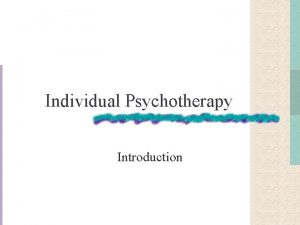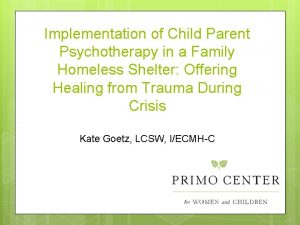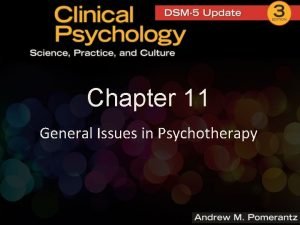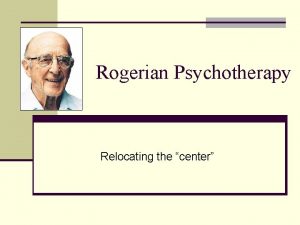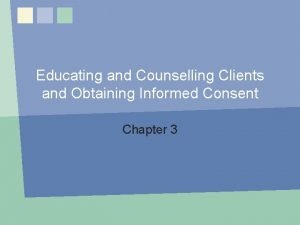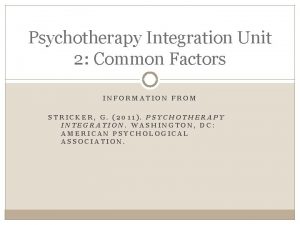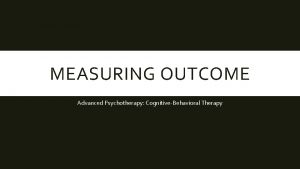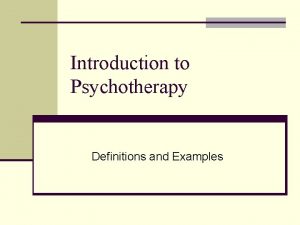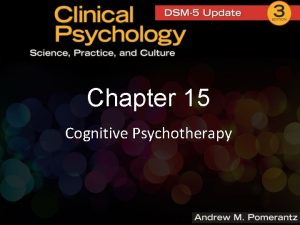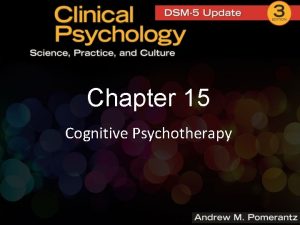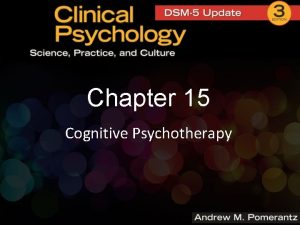Society for Psychotherapy Research UK Chapter 24 th



















- Slides: 19

Society for Psychotherapy Research UK Chapter 24 th Annual Meeting 25/03 - 27/03/2010 Ravenscar

Difficult Moments with Difficult Patients Therapist’s Experience and Negative Process Thomas A Schröder Institute of Work, Health & Organisations University of Nottingham

Thanks to: John D Davis Coventry and Warwickshire Partnership Trust Paul Gilbert Mental Health Research Unit, Derby, UK

Therapeutic Difficulties o Three perspectives on difficulties in psychotherapeutic practice: Therapist, patient, observer. o One approach to studying therapist’s perspective: Collecting and analysing retrospective accounts. o Initial investigation: Davis et al. (1987) – qualitative study resulting in taxonomy of therapist difficulties. o Taxonomy transformed into questionnaire format and included in ISDP. o Further data collections of difficulty narratives (anonymously to encourage candour). o Current data base of approx. 1000 difficulty accounts

Therapist Difficulties Study (Schröder & Davis 2004) o Convenient samples of 102 British and 30 German speaking therapists. Most results based on n=102 UK sample. o Sample Characteristics: 60% female; median age: 46; median practice length: 12 years; 63% psychologists, main theoretical influences (in descending order): psychodynamic, humanistic, cognitive. o Each participant anonymously provided two narratives of a therapeutic difficulty - with a ‘difficult’ and a ‘not-so -difficult’ patient – together with other measures serving as correlates.

Prompt for Eliciting Accounts: Please think of a situation which you have personally encountered in your practice of individual psychotherapy and which you found difficult. o What did you or your patient (client) do which made the situation difficult? o What feelings or personal reactions did you experience in the situation? o How did you attempt to deal or cope with this difficulty? o How did this situation turn out?

Therapist Difficulties Study o Three Difficulty categories, developed in previous qualitative study, were refined and manualised. o Trained raters judged ‘salience’ of each category for each difficulty narrative. ICCs ranging from. 73 -. 86. o Replication Design: 200 narratives were arranged into two independent arrays of 100 each for correlational studies.

Transient Difficulties: Related to deficits in knowledge, skills and experience. Not central to this paper.

Situational Difficulties: (abbreviated definition) These are difficulties which are inherent in the situation encountered by therapist. They would probably be experienced as difficult by most therapists encountering the situation… They are not reflective of therapist’s enduring personal characteristics.

Paradigmatic Difficulties: These are difficulties which arise out of the enduring characteristics of therapist experiencing them. They may be coped with, accommodated to, or somewhat modified over time, but they are essentially stable in nature. They are idiosyncratic and may be attributed to therapist’s internal conflicts, interpersonal style, or habitual ways of reacting. Their relatively unchanging character makes them typical of a particular therapist and the situation that evokes them would not be expected to cause similar difficulties for therapists in general. It would require far-reaching personal change for therapist to become free of such difficulties.

Paradigmatic Difficulties… o …can be understood as ‘conscious (or pre-conscious) countertransference’. (Marker variable: ‘Specificity’) o …have high emotional impact on therapists. (Metric: Emotional Impact Scale) o …occur more frequently with patients perceived by therapists as similar to themselves. (Metric: IIP Dissimilarity Index) o …evoke internal states in therapists similar to their worst and unlike their best self-representations. (Metric: SASB INTREX Therapist Introject Distance) o …arouse in therapists a wish for hostile control in the absence of perceived patient hostility.

Paradigmatic Difficulties… …arouse in therapists a wish for hostile control in the absence of perceived patient hostility Variables: SASB INTREX Cluster Scores Predominant association with ‘Hostile Control’ quadrant. SASB INTREX Affiliation Scores

Associations of SASB Affiliation Scores with Paradigmatic and Situational Difficulties * p <. 02 ** p <. 005 *** p <. 001 (two-tailed) Par. Diff. Sit. Diff. T. Introject -. 14 -. 41 *** T. Active with Pt. -. 14 -. 23 * T. Reactive to Pt. -. 14 Pt. Active with T. Pt. Reactive to T. -. 09 . 10 . 00 -. 07 -. 39 *** -. 14 . 03 . 07 -. 10 *** -. 24 -. 30 . 02 . 04 ** -. 21 -. 23

Extreme Case Analysis o Negative process cases: All cases where the sum of affiliation scores for ‘therapist active with patient’, ‘therapist reactive with patient' and ‘therapist introject’ is negative. o Rare Occurrence: Only 11% of cases (n=10 in cohort 1 and n=12 in cohort 2) fall into this category.

Difficulty Categories and Negative Process Median salience (0 -4) difficulty ratings for negative process cases: Transient: 1. 3 Situational: 1. 55 (1. 7 / 1. 4) Paradigmatic: 2. 45 (2. 5 / 2. 4) (1. 0 / 1. 6)

Therapists’ Self-conscious Emotion Experiences (Schröder & Gilbert 2005) Raters judge salience of four categories for each difficulty narrative. Four-rater ICCs: . 82 -. 93. 1. Guilt (empathic concern about having done harm to another) 2. External Shame (concern about having created a negative image of self in mind of other) 3. Internal Shame (concern about private negative evaluation of self) 4. Humiliation (concern about being unjustly denigrated by other)

Self-conscious Emotion Experiences and Negative Process Median salience (0 -4) difficulty ratings for negative process cases: (n=100) Guilt: . 3 External Shame: 1. 2 Internal Shame: 1. 0 Humiliation: 1. 0

Prototypical Case Account 1. Negative Process Case. 2. Introject and Transitive Affiliation Scores all negative. 3. Predominantly Paradigmatic salience ratings 4. Short enough to fit on a slide.

MALE CLINICAL PSYCHOLOGIST PSYCHODYNAMIC / COGNITIVE ORIENTATION The patient in question had entered into a 16 session contract aimed at looking at themes of loss in his life (of which there were several). He was at the time also attending a language clinic for speech therapy. a) the patient remarked he'd heard my wife was very nice, he had told his speech therapist that he was coming to see me, and the speech therapist told him about my wife (who is a speech therapist). He seemed to have gathered quite a lot of info about her appearance, personality, job etc. The information was all flattering to my wife and to me but. . . b) It felt like a huge boundary breakdown and he was getting all chummy/friendly with me. Felt intrusive. c) I told myself this was about jealousy and envy and he wanted what I had and what I had not lost. d) I couldn't get into it, I felt rattled. Instead I merely interpreted along the lines of him trying to distract our session content away from theme of loss. Later I realised that I was frightened that his emptiness could ''lose'' my wife. He was projecting his neediness inside of me and destroying what I had. A very powerful transference from a previously ''not difficult'' client. I don't like the fusion of my personal and work life. This is one split I prefer.
 Difference between guidance counseling and psychotherapy
Difference between guidance counseling and psychotherapy Andrew pethebridge
Andrew pethebridge Flooding ap psychology
Flooding ap psychology Re-educative individual psychotherapy
Re-educative individual psychotherapy Cpp triangle of explanation
Cpp triangle of explanation Cognitive psychology ppt
Cognitive psychology ppt Bracketing therapy
Bracketing therapy Dodo bird psychotherapy
Dodo bird psychotherapy General issues in psychotherapy
General issues in psychotherapy Who is carl rogers
Who is carl rogers Psychotherapy refers to
Psychotherapy refers to Sajjad urban dictionary
Sajjad urban dictionary Individual psychotherapy definition
Individual psychotherapy definition Quantum psychotherapy
Quantum psychotherapy Behavioral disputation
Behavioral disputation The common factors approach to psychotherapy integration
The common factors approach to psychotherapy integration Modelo cognitivo
Modelo cognitivo Advanced psychotherapy
Advanced psychotherapy Psychotherapy examples
Psychotherapy examples Limitations of psychotherapy
Limitations of psychotherapy



